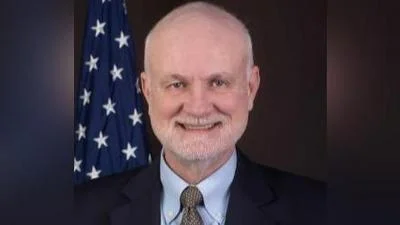John Taylor, Professor of Economics at Stanford University and developer of the "Taylor Rule" for setting interest rates | Stanford University
John Taylor, Professor of Economics at Stanford University and developer of the "Taylor Rule" for setting interest rates | Stanford University
Cells are highly controlled spaces that rely on every protein being in the right place. Many diseases, including cancers and neurodegenerative disorders, are associated with misplaced proteins. In some cancers, for instance, a protein that normally stands watch over DNA replicating in the nucleus is sent far from the DNA it is meant to monitor, allowing cancers to grow.
Steven Banik, assistant professor of chemistry in the School of Humanities and Sciences and institute scholar at Sarafan ChEM-H at Stanford University, and his lab have developed a new method to help force misplaced proteins back to their proper homes within cells. The method involves rewiring the activity of naturally occurring shuttles to help move proteins to different parts of the cell. The team has devised a new class of molecules called “targeted relocalization activating molecules” or TRAMs that convince these natural shuttles to take different cargo – like the proteins that get exported from the nucleus in some cancers – along for the ride. Published in Nature on Sept. 18, this strategy could lead to a therapeutic to correct the protein misplacement associated with diseases and also create new functions in cells.
“We are taking proteins that are lost and bringing them back home,” said Banik.
Our cells contain many compartments, like the nucleus, the secure home of DNA, or the mitochondria, where energy is produced. In between all these compartments is the cytoplasm. All throughout the cell’s many locations are proteins responsible for various actions such as building and breaking molecules, contracting muscles, and sending signals. For them to function properly, they must perform their respective actions in the right place.
“Cells are really crowded places,” said Banik. “Proteins are whizzing through the crowd passing by all kinds of other molecules like RNA, lipids, other proteins. So a protein’s function is limited by what it can do and by its proximity to other molecules.”
Diseases sometimes exploit this need for proximity by mutating proteins that might otherwise protect a cell from damage. These mutations can trick proteins into going where they would never go in healthy cells.
Sometimes this movement makes the protein stop working altogether. Proteins that act on DNA will not find any DNA in the cytoplasm and float off doing nothing. Other times this movement leads to a protein becoming harmful. In ALS (Amyotrophic Lateral Sclerosis), for example, a mutation sends a certain protein called FUS out of the nucleus into the cytoplasm where it aggregates into toxic clumps eventually killing the cell.
Banik and his team wondered whether they could combat this purposeful misplacement of proteins by using other proteins as shuttles to carry passenger proteins to their proper home. However, these shuttles often have other functions so they needed to convince them to take on cargo and transport it elsewhere.
To achieve this Banik's team developed TRAMs – two-headed molecules with one head designed to stick to the shuttle while the other sticks to the passenger protein. If strong enough, these shuttles carry passengers back to their rightful places.
The team focused on two promising types of shuttles: one that drags proteins into the nucleus and another that exports them from it. Christine Ng, a chemistry graduate student and first author on their paper designed TRAMs hitching together shuttle and passenger components effectively moving passengers between cellular locations when tested.
Ng faced an immediate challenge: there were no reliable methods available for measuring specific protein amounts within individual cells' locations at given times prompting her development of new quantification techniques combining microscopy skills with computational analysis expertise.
“Nature is inherently complex and interconnected so it's crucial having interdisciplinary approaches,” said Ng adding “Borrowing logic or tools from one field addressing problems in another often results in very exciting ‘what if’ questions discoveries.”
Her TRAMs successfully moved passenger proteins into/outside nuclei depending upon used shuttles generating basic design rules determining required strength overcoming directional pulls among others further challenges involved designing potential medicinal applications reversing disease-causing movements starting with ALS-associated FUS relocalizing experiments showing decreased toxic clumps improved cell survival rates next focusing well-known mouse mutation increasing neurodegeneration resistance effects mimicking successful stress-resistance enhancements seen via axonal travel facilitated via newly developed TRAM designs despite ongoing difficulties identifying binding targets future hopes lie discovering natural sticky pieces facilitating novel medicinal developments beyond mutated-protein returns exploring possibilities accessing inaccessible healthy-protein destinations creating unknown functionalities uncovering biological understandings
“It’s exciting because we are just starting learning rules,” stated Banik continuing “If shifting balance giving access new molecules parts times unlocking functions understanding biology.”
Banik holds memberships Bio-X Wu Tsai Human Performance Alliance additional Stanford co-authors include Aofei Liu former graduate student Bianxiao Cui Job Gertrud Tamaki Professor Chemistry member Bio-X Cardiovascular Institute Wu Tsai Neurosciences Institute faculty fellow Sarafan ChEM-H supported A*STAR fellowship NIH/NIGMS
Media contacts:
Rebecca McClellan Sarafan ChEM-H rmcclell@stanford.edu
News insights events delivered inbox weekday mornings
©CopyrightStanford University Stanford California 94305




 Alerts Sign-up
Alerts Sign-up